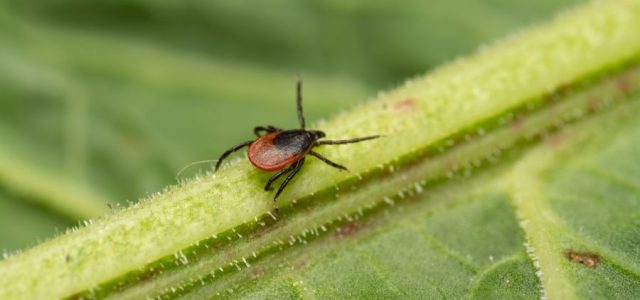Call for your appointment today 914-666-4665 | Mt. Kisco, New York

A patient came to my office in June with a bull’s-eye rash. “I checked myself after hiking,” she said, “but I never saw a tick.” She’d been bitten by a nymph — about the size of a poppy seed — but perfectly capable of transmitting Lyme disease. Her case was typical of what happens during deer tick season, when Lyme disease risk is at its highest.
If you’ve ever wondered when deer ticks are most common in the U.S., the answer depends on the tick’s life stage and the weather. Deer ticks, also known as blacklegged ticks (Ixodes scapularis), are the primary carriers of Borrelia burgdorferi, the bacteria that cause Lyme disease.
When Deer Tick Season Peaks
Their activity follows a clear seasonal pattern:
Nymphs are most active from mid-May through mid-July, when they’re tiny — the size of a poppy seed (about 1-2mm) — and much harder to see than adult ticks.
Adult deer ticks are active in spring and fall, whenever temperatures reach 45°F (7°C) or higher, with no snow cover. Adult ticks are roughly the size of a sesame seed, making them easier to spot but still small enough to go unnoticed.
Understanding deer tick season and Lyme disease patterns means recognizing that risk peaks in late spring and early summer but vigilance matters year-round.
Why the Nymph Stage Drives Most Infections
Up to 70% of Lyme disease cases are linked to nymphal-stage ticks, according to the CDC. Because these immature ticks are harder to see, they can stay attached long enough to transmit infection before being noticed.
It’s not exactly clear how long it takes for a tick to pass on an infection. You may have heard that it usually takes 36 to 48 hours, but in reality, it can happen sooner —especially if other infections like Babesia or Anaplasma are involved. Plus, most people underestimate how long a tick has actually been attached, so it’s hard to rely on that to judge your risk.
In my clinical experience, patients with detected and undetected nymphal and adult tick bites can develop chronic manifestations, including post-treatment Lyme disease symptoms such as brain fog, fatigue, and joint pain. Some patients develop neurologic complications, cardiac involvement, or debilitating chronic pain that disrupts work, relationships, and quality of life.
Where Deer Ticks Are Found
Many people assume ticks are only a wilderness problem, but deer ticks thrive in suburban yards, parks, and gardens — not just deep woods. They live in leaf litter, tall grass, shrubs, and wooded edges where they wait for hosts to brush past.
You don’t need to go hiking to encounter a tick. Gardening, playing in the yard, or walking your dog through neighborhood green spaces can all result in tick exposure.
Regional Differences in Deer Tick Season
Tick activity varies by region, but deer tick season is expanding as winters warm and spring arrives earlier.
- Northeast & Upper Midwest: Active April through October, with highest risk May–July
- Mid-Atlantic States: Peak activity late May to early August
- Southern States: Year-round potential, especially during mild winters
- Northern States: Activity slows with frost but rebounds quickly during thaws
Climate change is lengthening the tick season across the U.S. — a growing public-health concern for Lyme prevention.
Should I Take Antibiotics After a Tick Bite?
This is one of the most common questions I receive. The CDC recommends a single dose of doxycycline (200mg) for prophylaxis after a tick bite under specific circumstances: the tick was attached for ≥36 hours, it’s an deer tick, and doxycycline can be given within 72 hours of tick removal.
However, I have concerns about relying solely on single-dose prophylaxis. In my practice, I’ve seen patients who received the single dose and still went on to develop serious complications — including Bell’s palsy, Lyme arthritis, post-treatment Lyme disease syndrome (PTLDS), chronic Lyme symptoms, PANS (Pediatric Acute-onset Neuropsychiatric Syndrome), and POTS (Postural Orthostatic Tachycardia Syndrome).
Until we have stronger evidence that a single dose reliably prevents these outcomes, I remain cautious about assuming it offers complete protection. Early recognition of symptoms and full-course treatment when infection is suspected remain critical.
What to Do If You Find a Tick or Develop Symptoms
If you find an attached tick or develop symptoms within 30 days of potential exposure, seek medical evaluation immediately. Early treatment significantly improves outcomes.
My patient with the June bull’s-eye rash? She was treated promptly with a full course of antibiotics and recovered fully — a reminder that early recognition saves lives.
This post is intended for educational purposes and is not a substitute for professional medical advice. If you suspect you may have been exposed to Lyme disease, consult with a healthcare provider experienced in tick-borne illnesses.




I was diagnosed in 2009 after having 2 ticks and full rash.
I’ve had an immune disorder since and now have Lyme induced arthritis which is causing several issues from sore stuff joints to severe muscle fatigue and discomfort. Lyme is no joke but doctors state after antibiotic treatment you are cured and will not have further issues